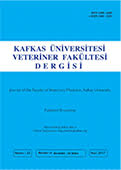
This journal is licensed under a Creative Commons Attribution-NonCommercial 4.0 International License
Kafkas Üniversitesi Veteriner Fakültesi Dergisi
2017 , Vol 23 , Issue 6
Identification, Characterization and Expression Analysis of Biglycan in Asian Elephant (Elephas maximus)
1Department of Biology, Faculty of Science, Chiang Mai University, Chiang Mai 50200, THAILAND2Excellent Center in Veterinary Bioscience, Chiang Mai University, Chiang Mai, 50200 THAILAND
3Department of Biology, Faculty of Science, Naresuan University, Phitsanulok 65000, THAILAND
4Science and Technology Research Institute, Chiang Mai University, Chiang Mai 50200, THAILAND
5Animal Bone and Joint Research Laboratory, Department of Veterinary Biosciences and Public Health, Faculty of Veterinary Medicine, Chiang Mai University, Chiang Mai 50100, THAILAND
6National Elephant Institute, Forest Industry Organization, Lampang, 52190, THAILAND
7Center of Excellence in Elephant Research and Education, Chiang Mai University, Chiang Mai 50200, THAILAND
8Thailand Excellence Center for Tissue Engineering and Stem Cells and Center of Excellence for Innovation in Chemistry, Department of Biochemistry, Faculty of Medicine, Chiang Mai University, Chiang Mai 50200, THAILAND DOI : 10.9775/kvfd.2017.17945 The aims of this study were to investigate the coding sequence and the deduced amino acid sequence of Asian elephant"s biglycan gene as well as its expression in different tissues and conditions using wound healing as a model. The results showed that Asian elephant biglycan coding sequence was 1,110 base pair (bp) long (accession number: JQ753329), encoding 369 amino acids. The coding and amino acid sequences between Asian and African elephants revealed 99% and 98% similarity, respectively. The conserved domains of biglycan protein were also observed. In addition, its expression was found in 15 tissues with a predominant expression in cartilage and spleen. For expression analysis in the wound healing process, it was found that the level of biglycan mRNA was influenced by many factors, including age, type of wound and stage of wound healing. Keywords : Asian elephants, Biglycan, Gene expression, Sequencing, Wound healing










